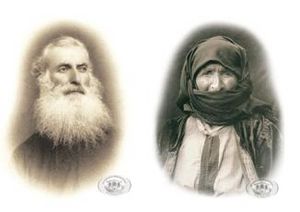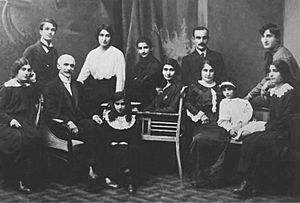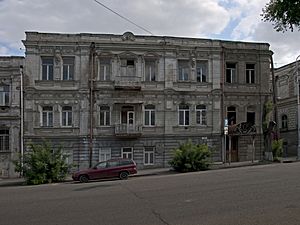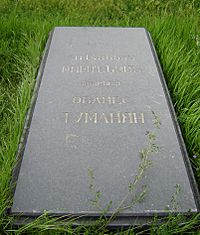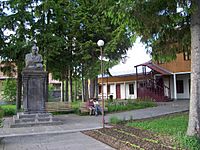Hovhannes Tumanyan facts for kids
Quick facts for kids
Hovhannes Tumanyan
|
|
|---|---|
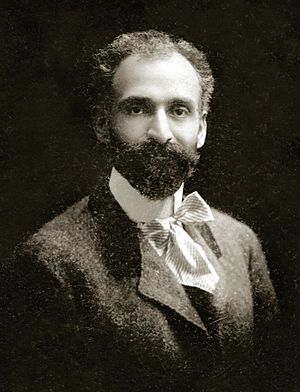 |
|
| Born | February 19, 1869 Dsegh, Tiflis Governorate, Russian Empire (now Lori Province, Armenia) |
| Died | March 23, 1923 (aged 54) Moscow, Russian SFSR, Soviet Union |
| Resting place | Armenian Pantheon of Tbilisi |
| Occupation | poet, novelist, public activist |
| Nationality | Armenian |
| Period | 1881–1923 |
| Literary movement | Realism |
| Spouse | Olga Tumanyan (née Matchkalyan) |
| Children | 10, including Tamar Tumanyan |
| Signature | |
Hovhannes Tumanyan (Armenian: Հովհաննես Թումանյան, born February 19, 1869 – died March 23, 1923) was a famous Armenian poet, writer, and translator. He was also a public activist. Many people know him as the national poet of Armenia.
Tumanyan wrote many different kinds of stories and poems. He created poems, short verses called quatrains, long story-poems called ballads, and novels. He also wrote fables, which are stories with a moral. His writing often showed the everyday life of people during his time. He was born in the village of Dsegh in the Lori region. When he was young, he moved to Tiflis. This city was a big center for Armenian culture back then. Soon, many Armenians knew his simple but beautiful works.
Some of Tumanyan's stories have been made into movies and cartoons. Two operas, Anush and Almast, were also created from his works.
Contents
Life Story of Hovhannes Tumanyan
Hovhannes Tumanyan was born on February 19, 1869. His birthplace was the village of Dsegh in what was then the Russian Empire. Today, this village is in Lori Province, Armenia.
His father, Aslan, was a village priest. His family was part of an old Armenian princely family. His mother, Sona, loved telling stories, especially fables. Hovhannes was the oldest of eight children in his family.
Growing Up and School
From 1877 to 1879, Tumanyan went to school in Dsegh. Then, from 1879 to 1883, he studied in a school in Jalaloghly. In 1883, he moved to Tiflis. There, he attended the Nersisyan School until 1887. Tumanyan wrote his very first poem when he was only 12 years old.
From 1893 onwards, Tumanyan worked for several magazines and newspapers. He also became involved in helping his community.
The "Vernatun" Group
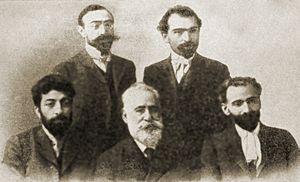
In 1899, Tumanyan started a special gathering at his house in Tiflis. Armenian writers and thinkers would meet there. They often met in the "garret" or attic of his house. Because of this, the group was called "Vernatun," which means "garret" in Armenian.
Many famous Armenian writers were part of this group. These included Avetik Isahakyan, Derenik Demirchyan, and Ghazaros Aghayan. The Vernatun group was very important for Armenian literature. It met regularly until 1908.
Later Life and Passing
In 1912, Tumanyan was chosen to lead the Company of Caucasus Armenian Writers. In late 1921, he traveled to Constantinople. He went there to help Armenian refugees who needed support. After months, he returned home feeling unwell. He had surgery in 1922 and started to get better. However, his health worsened again in September. He was moved to a hospital in Moscow. Hovhannes Tumanyan passed away there on March 23, 1923.
Family Life
In 1888, when he was 19, Hovhannes Tumanyan married Olga Matchkalyan. She was 17 years old. They had a large family with 10 children. Their children were Musegh, Ashkhen, Nvard, Artavazd, Hamlik, Anush, Arpik, Areg, Seda, and Tamar.
Hovhannes Tumanyan's Public Work
Tumanyan was not just a writer; he was also a peacemaker. During the Armenian–Tatar massacres of 1905–1907, he tried to bring peace. He was even arrested twice for his efforts. He also spoke out against the Georgian–Armenian War in 1918. Tumanyan also believed strongly in helping others. He once wrote that "There is only one way of salvation; through Jesus Christ abiding inside every one of us."
In October 1914, he joined a group called the "Committee for Support of War Victims." This group later helped many Armenian Genocide refugees. They found safety in Etchmiadzin. In 1921, he started the House of Armenian Art in Tiflis.
Hovhannes Tumanyan's Writings
Tumanyan's writing style is simple and natural. Yet, it is also full of poetic beauty. Many phrases from his works are now common sayings in everyday Armenian language.
People often call Tumanyan the "All-Armenian poet." He earned this title because he stood up for all Armenians. Once, when refugees were not allowed into certain church areas, Tumanyan spoke out. He said that as "The Poet of all Armenians," he believed the refugees should be helped.
He wrote many types of literature. These included lyrics, fables, and long epic poems. He also translated works by famous writers like Byron, Goethe, and Pushkin into Armenian.
Famous Works by Tumanyan
Ballads and Poems
|
Novels
Fairy Tales
|
Tumanyan's Lasting Impact
Hovhannes Tumanyan's works continue to be loved and studied. His stories and poems have been translated into many languages.
Translations of His Work
Famous writers like Valeri Bryusov, Joseph Brodsky, and Samuil Marshak have translated Tumanyan's works.
Places Named After Tumanyan
Many places in Armenia and beyond are named in his honor:
- His home village of Dsegh was named Tumanyan for a while.
- Tumanyan City in Lori Province is named after him.
- The Pedagogical University of Vanadzor carries his name.
- The Armenian State Puppet Theater in Yerevan is named after him.
- There's a Tumanyan Street in central Yerevan.
- Tumanyan Park is in Yerevan's Ajapnyak district.
Outside Armenia, you can find:
There are two museums dedicated to Tumanyan in Armenia. One is in his birthplace, Dsegh. The other is in Yerevan and opened in 1953. In 2017, a museum and cultural center opened in Tbilisi. This was in the flat where Tumanyan once lived.
See also
 In Spanish: Hovhannes Tumanyan para niños
In Spanish: Hovhannes Tumanyan para niños
- Armenian literature
- Armenians in Georgia
- Armenians in Tbilisi


